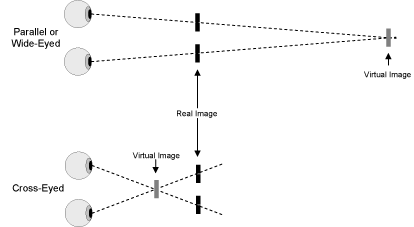
Most people have two eyes and because the eyes are separated by a few inches, we have binocular vision. That is, when we view something in the real world, each eye sees things from a slightly different viewpoint.
Over the years, there have been a myriad of ways employed to present and view stereographic images. The basic concept is to present one image to one eye and another image to the other eye. The brain fuses the two together to produce a sense of depth. All sorts of projectors, materials, devices and glasses are used to assist, but really all you need are two good eyes.
There are two methods for “free-viewng” or “free-fusion” as it is sometimes called: the parallel viewing method and the cross-eyed method.
As shown in the diagram below, the depth effect is reversed for the two types of free viewing. For some simple stereograms, it may not make much of a difference which technique you use, but for most, especially for those which have overlapping objects, only one technique will be appropriate. Single Viewpoint Stereograms, which are the main focus of this site, all require cross-eyed viewing.

So the big question is “How do I do that?”
Almost everyone can cross his or her eyes. We all did it regularly as kids even though our moms warned us they would get stuck (not true, by the way). Go ahead and put your finger in front of your nose and try to look at it with both eyes. Your eyes will naturally cross.
But, crossing them in a controlled manner while keeping things in focus may take a while to do and requires some practice. The good news is that once you have practiced it a few times, it will get easier to do till eventually it becomes very easy.
Here is a very simple example which will help you practice crossing your eyes. Hold your head straight and look at the two circles below with the black boxes in them. Now cross your eyes (you might employ the finger again to get you started). Now, you should see more than two circles. If you see three, great. If you see four, it means your eyes crossed too much. Try to uncross them a little until you see just three.

Now that you see three, do you notice the stereographic effect? The black box in the middle circle looks closer to you than the circle. If it looks farther away than the circle, you are not crossing your eyes, but are using the parallel method. In this case start over, and make sure you are crossing them.
Many of the images on this site have guides near the top you can use to get your eyes just right. When you see three dots, everything is correct. Other images don’t have guides, but you can pick out two adjacent objects and use them. Once you are locked onto the scene, everything should look 3D.
One other note that will help if you print the images. Make sure you have good lighting to view the prints. Poor lighting will definitely hamper your ability to focus.